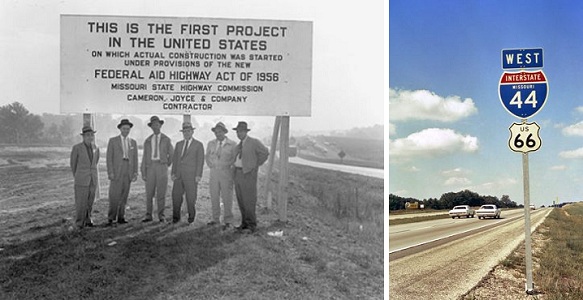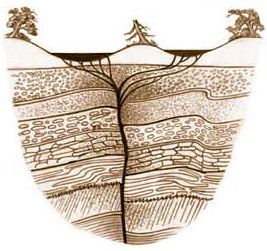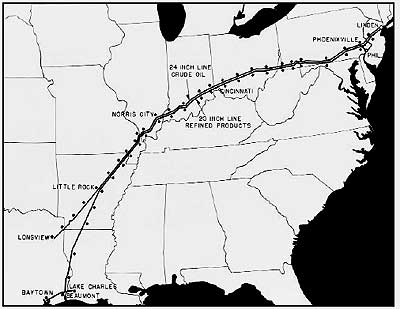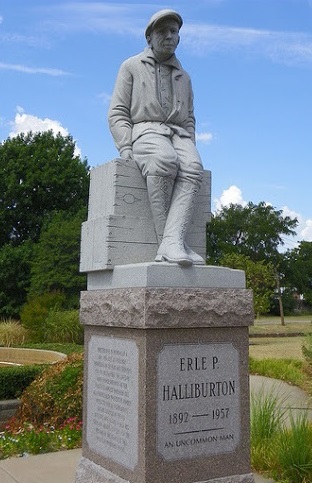by Bruce Wells | Jul 31, 2023 | This Week in Petroleum History
August 1, 1872 – Iron Pipeline delivers Pennsylvania Natural Gas –
The first recorded large-scale delivery of natural gas by pipeline began when gas was sent to more than 250 residential and commercial customers in Titusville, Pennsylvania, home of America’s first oil well, drilled in 1859. The two-inch iron pipeline carried the natural gas five miles from a well producing four million cubic feet of natural gas a day.
The mayor of Titusville and other investors had formed the Keystone Gas & Water Company to construct the pipeline for delivering “the most powerful and voluminous gas well on record.”
The historic gas well produced into the 1880s, according to the Drake Well Museum and Park in Titusville.
August 2, 1956 – Missouri builds First U.S. Interstate Highway
Missouri became the first state to award a contract with interstate construction funding authorized two months earlier by the Federal-Aid Highway Act. The highway commission agreed to begin work on part of Route 66, now Interstate 44.

Missouri launched the U.S. interstate system after “inking a deal for work on U.S. Route 66.” Today, I-44 stretches across south central Missouri and is a major corridor linking the Midwest and the West Coast.
“There is no question that the creation of the interstate highway system has been the most significant development in the history of transportation in the United States,” proclaimed the Missouri Department of Transportation.
Learn more transportation and oil history in America on the Move.

August 3, 1769 – La Brea Asphalt Pits discovered
A Spanish expedition discovered what would be called La Brea (the tar) pits on the West Coast. “We debated whether this substance, which flows melted from underneath the earth, could occasion so many earthquakes,” noted the expedition’s Franciscan friar in his diary.

Outside the Page Museum of Los Angeles, life-size replicas of several extinct mammals are featured at the Rancho La Brea in Hancock Park. Although called the “tar pits,” the pools are actually asphalt.
The friar, Juan Crespi, was the first person to use the term “bitumen” in describing these sticky pools in southern California — where crude oil has been seeping from the ground through fissures in the coastal plain sediments for more than 40,000 years. Native Americans used the substance for centuries to waterproof baskets and caulk canoes.

Pools form when crude oil seeps to the surface through fissures in the earth’s crust.
Although popularly called the tar pits, the pools at Rancho La Brea are actually asphalt — not tar, which is a by-product made by the distillation of woody materials, such as peat. Asphalt is a naturally formed substance comprised of hydrocarbon molecules (see Asphalt Paves the Way).
Learn more in Discovering the Le Brea Tar Pits.
August 3, 1942 – War brings “Big Inch” and “Little Big Inch” Pipelines
War Emergency Pipelines Inc. began construction on the “Big Inch” line — the longest petroleum pipeline project ever undertaken in the United States. Conceived to supply wartime fuel demands — and in response to U-boat attacks on oil tankers along the eastern seaboard and Gulf of Mexico, the “Big Inch” and “Little Big Inch” lines were extolled as “the most amazing government-industry cooperation ever achieved.”

The longest petroleum pipeline project ever undertaken led to construction of a 24-inch pipeline from East Texas to Illinois, and a 20-inch line as far as New York City.
With a goal of transporting 300,000 barrels of oil per day, the $95 million project called for construction of a 24-inch pipeline (Big Inch) from East Texas to Illinois, and a 20-inch line (Little Big Inch) as far as New York and Philadelphia — more than 1,200 miles (the Trans-Alaska pipeline system is 800 miles long).
Learn more in Big Inch Pipelines of WWII.
August 4, 1913 – Discovery of Oklahoma’s “Poor Man’s Field”
The Crystal Oil Company completed its Wirt Franklin No. 1 well 20 miles northwest of Ardmore, Oklahoma. The well revealed the giant Healdton field, which became known as the “poor man’s field,” because of its shallow depth and low cost of drilling. The area attracted many independent producers with limited financial backing.

The Healdton Oil Museum includes IPAA founder Wirt Franklin’s Pierce-Arrow. The museum hosts annual oil history events.
Another major oil discovery in 1919 revealed the Hewitt field, which extended oil production in a 22 mile swath across Carter County. The Greater Healdton-Hewitt oilfield produced, “an astounding 320,753,000 barrels of crude by the close of the first half of the 20th century,” noted historian Kenny Franks.
In 1929, Wirt Franklin became the first president of the then Tulsa-based Independent Petroleum Association of America (IPAA). Erle Halliburton perfected his method of cementing oil wells in the Healdton field (see Halliburton and the Healdton Oilfield).
Learn more about Oklahoma’s historic “poor man’s field” by visiting the Healdton Oil Museum.
August 4, 1977 – U.S. Department of Energy established
President Jimmy Carter signed the Department of Energy Organization Act, which established the twelfth cabinet-level department by consolidating a dozen agencies and energy-related programs of the federal government. The new department combined the Federal Energy Administration and Energy Research and Development Administration; DOE also became responsible for nuclear weapon programs and national labs. James Schlesinger was sworn in as first Secretary of Energy.
_______________________
Recommended Reading: The Big Roads: The Untold Story of the Engineers, Visionaries, and Trailblazers Who Created the American Superhighways (2012); Monsters Of Old Los Angeles – The Prehistoric Animals Of The La Brea Tar Pits
(2012); Monsters Of Old Los Angeles – The Prehistoric Animals Of The La Brea Tar Pits (2008); Oil: From Prospect to Pipeline
(2008); Oil: From Prospect to Pipeline (1971); Ragtown: A History of the Greater Healdton-Hewitt Oil Field
(1971); Ragtown: A History of the Greater Healdton-Hewitt Oil Field (1989). Amazon purchases benefit the American Oil & Gas Historical Society. As an Amazon Associate, AOGHS earns a commission from qualifying purchases.
(1989). Amazon purchases benefit the American Oil & Gas Historical Society. As an Amazon Associate, AOGHS earns a commission from qualifying purchases.
_______________________
The American Oil & Gas Historical Society (AOGHS) preserves U.S. petroleum history. Become an AOGHS annual supporting member and help maintain this energy education website and expand historical research. For more information, contact bawells@aoghs.org. Copyrihttp://homeght © 2023 Bruce A. Wells. All rights reserved.
by Bruce Wells | Jul 25, 2023 | Petroleum Pioneers
A shallow Oklahoma oilfield launched many petroleum careers.
When a 1919 drilling boom arrived at a shallow oilfield at Healdton, Oklahoma, a 27-year-oid inventor applied his new method for cementing oil wells. His oilfield service in company would become one of the largest in the world.
Erle Palmer Halliburton (1892-1957) received a U.S. patent for his “Method and Means for Cementing an Oil Well in 1921 during Oklahoma drilling booms in and around the Healdton oilfield. He had arrived in Duncan after working for service companies in North Texas towns, including boom town Burkburnett.
Halliburton’s New Method Oil Well Cementing Company would receive many patents on its way to becoming Halliburton Corporation, which in 2022 employed 42,000 worldwide specializing in “locating hydrocarbons and managing geological data, to drilling and formation evaluation, well construction and completion, and optimizing production through the life of the field.”

The Healdton Oil Museum includes IPAA founder Wirt Franklin’s Pierce-Arrow. The museum hosts annual oil history events.
The Healdton field was first revealed in August 1913 by the Wirt Franklin No. 1 well about 20 miles northwest of Ardmore. The wildcat well discovered what soon became known as the “poor man’s field,” because of its shallow depth and low cost of drilling.
The Carter County oilfield, about 70 miles east of Burkburnett, quickly attracted independent producers with limited financial backing — often edging out major oil company competitors.

“Within a 22-mile swath across Carter County, one of the nation’s greatest oil discoveries was made — the Greater Healdton-Hewitt Field,” reported Kenny Arthur Franks in his 1989 history of the oilfield.
“Encompassing some of the richest oil-producing land in America, Healdton and Hewitt, discovered in 1913 and 1919 respectively, produced an astounding 320,753,000 barrels of crude by the close of the first half of the 20th century,” Franks explained.

Erle P. Halliburton Halliburton in 1957. Photo courtesy Oklahoma Hall of Fame.
In addition to launching Halliburton’s petroleum career, the shallow field also helped independent producer Wirt Franklin in 1929 become the first president of the then Tulsa-based Independent Petroleum Association of America (IPAA).
The Healdton Oil Museum preserves Franklin’s and other independent producers’ exploration heritage — and many who got their start in the Healdton field. Among them were former Oklahoma Governor Charles Haskell and Roy Johnson, president of the Healdton Petroleum Company.
According to the Oklahoma Historical Society (OHS), the towns of Wilson, Ringling, and New Healdton (now Healdton) came into existence during the oilfield’s development. Just a few who began their careers there were Robert Hefner Sr. and Lloyd Noble.
“Hefner, a lawyer, introduced the concept of subsurface leasing into mineral rights law,” OHS notes. “Noble developed an international oil business and established the Samuel Roberts Noble Foundation, a nonprofit biotechnology research foundation that helps farmers.”
Born in Ardmore in 1896, Noble found early success at Healdton — and at the Seminole oil boom in 1926.

Noble also was instrumental in the success of a top-secret drilling project during World War II (see Roughnecks of Sherwood Forest).
Cement Well Control
Healdton drilling boom and its many shallow wells, Halliburton established his New Method Oil Well Cementing in Duncan. He was soon experimenting with technologies to improve oil well production. Water intrusion hampered many wells, requiring time and expense for pumping out.
Halliburton noted in his 1920 patent application, “Water has caused the abandonment of many wells which would have developed a profitable output.”
The oilfield cementing innovation — at first resisted by some skeptics — isolated the various down-hole zones, guarded against collapse of the casing and permitted control of the well throughout its producing life.

The city of Duncan, Oklahoma, dedicated a Halliburton statue in 1993.
According to William Pike, former editor-in-chief of E&P magazine, Halliburton’s well cementing process revolutionized how oil and natural gas wells were completed.
Halliburton also patented other modern cementing technologies, including the jet mixer, the remixer and the float collar, guide shoe and plug system, bulk cementing, multiple-stage cementing, advanced pump technology and offshore cementing technology.
Halliburton’s only real service company competitor for decades was Carl Baker of Baker Oil Tools. Halliburton Oil Well Cementing Company in 1938 expanded into offshore work with a barge-mounted unit cementing a well off the Louisiana coast.

Meanwhile, another Oklahoma oilfield service company, the Reda Pump Company, had been founded by Armais Arutunoff, thanks to help from his close friend Frank Phllips and Phillips Petroleum of Bartlesville, Oklahoma.
Arutunoff invented a practical electric submersible pump). As Phillips foresaw, use of the Arutunoff artificial lift pump would dominate U.S. oilfields by 1938 — and oilfields worldwide after World War II.
Hydraulic Fracking
A major petroleum industry milestone came in 1949, when Halliburton and Stanolind Oil Company completed a well near Duncan, Oklahoma – the first commercial application of hydraulic fracturing (see Shooters – A “Fracking” History).
“Halliburton was ever the tinkerer. He owned nearly 50 patents,” noted Pike. “Most are oilfield, and specifically cementing related, but the number includes patents for an airplane control, an opposed piston pump, a respirator, an airplane tire and a metallic suitcase.”
Thanks in part to his prospering oilfield service company, Halliburton in 1931 started his own airline in Tulsa, the Southwest Air Fast Express — Safeway Airlines — that later merged with American Airlines.
As U.S. production from oil and natural gas shale formations grew in 2018, Halliburton Corporation’s worldwide operations employed 80,000 people.
Learn more about Halliburton’s oilfield inventiveness in Halliburton cements Wells.
_______________________
Recommended Reading: Ragtown: A History of the Greater Healdton-Hewitt Oil Field (1989); Erle P. Halliburton: Genius with Cement (1959). Your Amazon purchase benefits the American Oil & Gas Historical Society. As an Amazon Associate, AOGHS earns a commission from qualifying purchases.
(1959). Your Amazon purchase benefits the American Oil & Gas Historical Society. As an Amazon Associate, AOGHS earns a commission from qualifying purchases.
_______________________
The American Oil & Gas Historical Society (AOGHS) preserves U.S. petroleum history. Become an AOGHS supporting member and help maintain this energy education website and expand historical research. For more information, contact bawells@aoghs.org. © 2023 Bruce A. Wells.
Citation Information – Article Title: “Halliburton and the Healdton Oilfield.” Authors: B.A. Wells and K.L. Wells. Website Name: American Oil & Gas Historical Society. URL: https://aoghs.org/petroleum-pioneers/halliburton-and-healdton-oilfield. Last Updated: April 29, 2023. Original Published Date: July 14, 2015.





(2012); Monsters Of Old Los Angeles – The Prehistoric Animals Of The La Brea Tar Pits
(2008); Oil: From Prospect to Pipeline
(1971); Ragtown: A History of the Greater Healdton-Hewitt Oil Field
(1989). Amazon purchases benefit the American Oil & Gas Historical Society. As an Amazon Associate, AOGHS earns a commission from qualifying purchases.




